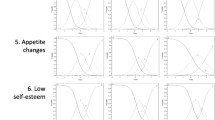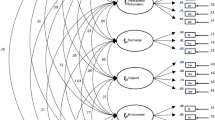Abstract
Objectives
The aims of the study are: first, to compare two short diagnostic instruments, CIDI-SF and CIS-R, with respect to the structured clinical interview for non-patient (SCID-I/NP) for anxiety and depressive disorders; and second, to evaluate the influence of four languages, Italian, Romanian, Spanish and French, on the concordance tests.
Methods
A total of 120 participants from Italy and Romania, 119 from Spain and 141 from France (N = 500) were recruited randomly in a local primary care research centre (GPs or medical centres). The instruments were administered during a unique session: the lay instruments by students in psychology and the SCID by experienced psychiatrists. Kappa, sensitivity/specificity/negative (NPV) and positive predictive values (PPV), ROC curve (AUC) and the Youden Index (Y) were calculated.
Results
Results were better for the CIDI-SF than the CIS-R for anxious disorders, depressive disorders and any of them. The results were identical to that obtained by the CIDI 3.0 for the three categories and constant across the languages except for depressive disorders in Romania and France.
Conclusions
CIDI-SF is a cost-effective instrument and could be easily integrated into health surveys; its performance values are better across languages than values proposed by the CIS-R and could be increased by inclusion of few additional information.
Similar content being viewed by others
References
Aalto-Setälä T, Haarasilta L, Marttunen M, Tuulio-Henriksson A, Poikolainen K, Aro H et al (2002) Major depressive episode among young adults: CIDI-SF versus SCAN consensus diagnoses. Psychol Med 32:1309–1314
American Psychiatric Association (2002) Diagnostic and statistical manual of mental disorders (DSM-IV-TR), 4th edn. American Psychiatric Association, Washington, DC
Araya R, Rojas G, Fritsch R, Acuna J, Lewis G (2001) Common mental disorders in Santiago, Chile: prevalence and socio-demographic correlates. Br J Psychiatry 178:228–233
Beaudet MP (1997) Dépression. Health Rep 7:171–185
Bhui K, Bhugra D, Goldberg D (2000) Cross-cultural validity of the Amritsar Depression Inventory and the General Health Questionnaire amongst English and Punjabi primary care attenders. Soc Psychiatry Psychiatr Epidemiol 35(6):248–254
Botega NJ, Pereira WA, Bio MR, Garcia C Jr, Zomignani MA (1995) Psychiatric morbidity among medical in-patients: a standardized assessment (GHQ-12 and CIS-R) using ‘lay’ interviewers in a Brazilian hospital. Soc Psychiatry Psychiatr Epidemiol 30(3):127–131
Bromet EJ, Dunn LO, Connell MM, Dew MA, Schulberg HC (1986) Long-term reliability of diagnosing lifetime major depression in a community sample. Arch Gen Psychiatry 43:435–440
Brugha TS, Jenkins R, Bebbington P, Meltzer H, Lewis G, Farrell M (2004) Risk factors and the prevalence of neurosis and psychosis in ethnic groups in Great Britain. Soc Psychiatry Psychiatr Epidemiol 39:939–946
Brugha TS, Meltzer H, Jenkins R, Bebbington PE, Taub NA (2005) Comparison of the CIS-R and CIDI lay diagnostic interviews for anxiety and depressive disorders. Psychol Med 35(7):1089–1091
Brugha TS, Weich S, Singleton N, Lewis G, Beddington PE, Jenkins R, Meltzer H (2005) Primary group size, social support, gender and future mental health status in a prospective study of people living in private households throughout Great Britain. Psychol Med 85:708–714
Burton JW, Singleton N, Melzer D (2004) The mental health of early retirees: national interview survey in Britain. Soc Psychiatry Psychiatr Epidemiol 40:99–105
Cho H, Costa E, Menezes P, Chalder T, Bhugra D, Wessely S (2007) Cross-cultural validation of the Chalder Fatigue Questionnaire in Brazilian primary care. J Psychosomatic Res 62(3):301–304
Commander MJ, Sashi Dharan SP, Odell SM, Surtees PG (1997) Access to mental health care in an inner city health district. I: pathways into and within-specialist psychiatric services. Br J Psychiatry 170:312–316
Cooke D, Newman S, Sacker A, Devellis B, Bebbington P, Meltzer H (2007) The impact of physical illnesses on non-psychotic psychiatric morbidity: data from the household survey of psychiatric morbidity in Great Britain. Br J Health Psychol 12(Pt 3):463–471
DeLong ER, DeLong DM, Clarke-Pearson DL (1988) Comparing the areas under two or more correlated receiver operating curves: a nonparametric approach. Biometrics 44:837–845
ESEMeD/MHEDEA 2000 Investigators (2004) Prevalence of mental disorders in Europe: results from the European Study of the Epidemiology of Mental Disorders (ESEMeD) project. Acta Psychiatr Scand 109(Suppl 420):21–27
First MB, Spitzer RL, Gibbon M, Williams JBW (2002) Structured clinical interview for DSM-IV Axis I Disorders, Research Version, Non-Patient Edition (SCID-I/NP). Biometrics Research, New York State Psychiatric Institute, New York. http://www.scid4.org/psychometric/scidI_validity.hml
Hanley JA, McNeil BJ (1982) The meaning and use of the area under a receiver operating characteristic (ROC) curve. Radiology 143:29–36
Haro JM, Arbabzadeh-Bouchez S, Brugha TS, De Girolamo G, Guyer ME, Jin R, Lepine JP, Mazzi F, Reneses B, Vilagut G, Sampson NA, Kessler RC (2006) Concordance of the composite international diagnostic interview Version 3.0 (CIDI 3.0) with standardized clinical assessments in the WHO World Mental Health Surveys. Int J Methods Psychiatr Res 15(4):167–180
Isometsa E, Aro S, Aro H (1997) Depression in Finland: a computer-assisted telephone interview study. Acta Psychiatr Scand 96(2):122–128
Jordanova V, Wickramesinghe C, Gerada C, Prince M (2004) Validation of two survey diagnosis interviews among primary care attendees: a comparison of CIS-R and CIDI with SCAN ICD-10 diagnosis categories. Psychol Med 34:1013–1023
Kessler RC, Wittchen HU, Abelson J, Zhao S (2000) Methodological issues in assessing psychiatric disorder with self-reports. In: Stone AA, Turrkan JS, Bachrach CA, Jobe JB, Kurtzman HS, Cain VS (eds) The science of self-report: implications for research and practice. Lawrence Erlbaum Associates, Mahwah, pp 229–255
Kessler RC, Andrews G, Mroczek D, Üstün B, Wittchen HU (1998) The World Health Organization composite international diagnostic interview short form (CIDI-SF). Int J Methods Psychiatr Res 7:171–185
Korkeila J, Lehtinen V, Bijl R, Dalgrad OS, Kovess V, Morgan A, Salize HJ (2003) Establishing a set of mental health indicators for Europe. Scand J Public Health 31:451–459
Kovess V, The State of Mental Health in The European Union Collaborators. (2004). The State of Mental Health in the European Union. European Communities. http://ec.europa.eu/health/ph_projects/2001/monitoring/fp_monitoring_2001_frep_06_en.pdf. Accessed 26 July 2007
Kovess V, Fournier L, Lesage A, Amiel-Lebigre F, Caria A (2001) Two validation studies of the CIDIS: a simplified version of the CIDI. Psychiatric Netw 4:10–24
Lehtinen V, Sohlman B, Kovess-Masféty V (2005) Level of positive mental health in the European Union: results from the Eurobarometer 2002 survey. Clin Pract Epidemol Ment Health 1:9
Lewis G, Pelosi AJ (1990) Manual of the revised clinical interview schedule (CIS-R). Institute of Psychiatry, London
Lewis G, Pelosi AJ, Araya R, Dunn G (1992) Measuring psychiatric disorder in the community: a standardized instrument for use by lay interviewers. Psychol Med 22:465–486
Liu SI, Mann A, Cheng A, Tjung JJ, Hwang LC (2004) Identification of common mental disorders by general medical doctors in Taiwan. Gen Hosp Psychiatr 26(4):282–288
National population health survey- public use microdata files-household component. (1998). Statistics Canada, Ottawa. Cat no. 82M0009XCB
Patten SB, Brandon-Christie J, Devji J, Sedmak B (2000) Performance of the composite international diagnostic interview short form for major depression in a community sample. Chronic Dis Can 21:68–72
Patten SB, Wang JL, Beck CA, Maxwell CJ (2005) Measurement issues related to the evaluation and monitoring of major depression prevalence in Canada. Chronic Dis Can Fall 26(4):100–106
Perneger TV, Leplège A, Etter JF (1999) Cross-cultural adaptation of a psychometric instrument: two methods compared. J Clin Epidemiol 52(11):1037–1046
Walters EE, Kessler RC, Nelson CB, Mroczek D (2002) Scoring the World Health Organization’s composite international diagnostic interview short form (CIDI-SF). http://www.who.int/msa/cidi/cidisfscorint.pdf
Weich S, Nazroo J, Sproston K, McManus S, Blanchard M, Erens B, Karlsen S, King M, Lloyd K, Stanfeld S, Tyrer P (2004) Common disorders and ethnicity in England: the EMPIRIC study. Psychol Med Nov 34(8):1543–1551
Wing JK, Babor T, Brugha TE, Burke J, Cooper JE, Giel R, Jablenski A, Regier D, Sartorius N (1990) SCAN: schedules for clinical assessment in neuropsychiatry. Arch Gen Psychiatry 47:589–593
Wittchen HU, Jacobi F (2005) Size and burden of mental disorders in Europe: a critical review and appraisal of 27 studies. Eur Neuropsychopharmacol 15:357–376
World Health Organisation (1990) The composite international diagnostic interview (version 1.0). World Health Organisation, Geneva
World Health Organization (1992) The ICD-10 classification of mental and behavioural disorders: clinical descriptions and diagnostic guidelines. World Health Organisation, Geneva
Conflict of interest statement
The paper presents results of the MINDFUL project conducted with the EA 4069 Paris Descartes University and the MGEN Foundation for Public Health, which received funding from the European Union, within the framework of the Public Health Program Grant No. 2003119.
Author information
Authors and Affiliations
Corresponding author
Rights and permissions
About this article
Cite this article
Pez, O., Gilbert, F., Bitfoi, A. et al. Validity across translations of short survey psychiatric diagnostic instruments: CIDI-SF and CIS-R versus SCID-I/NP in four European countries. Soc Psychiat Epidemiol 45, 1149–1159 (2010). https://doi.org/10.1007/s00127-009-0158-6
Received:
Accepted:
Published:
Issue Date:
DOI: https://doi.org/10.1007/s00127-009-0158-6




